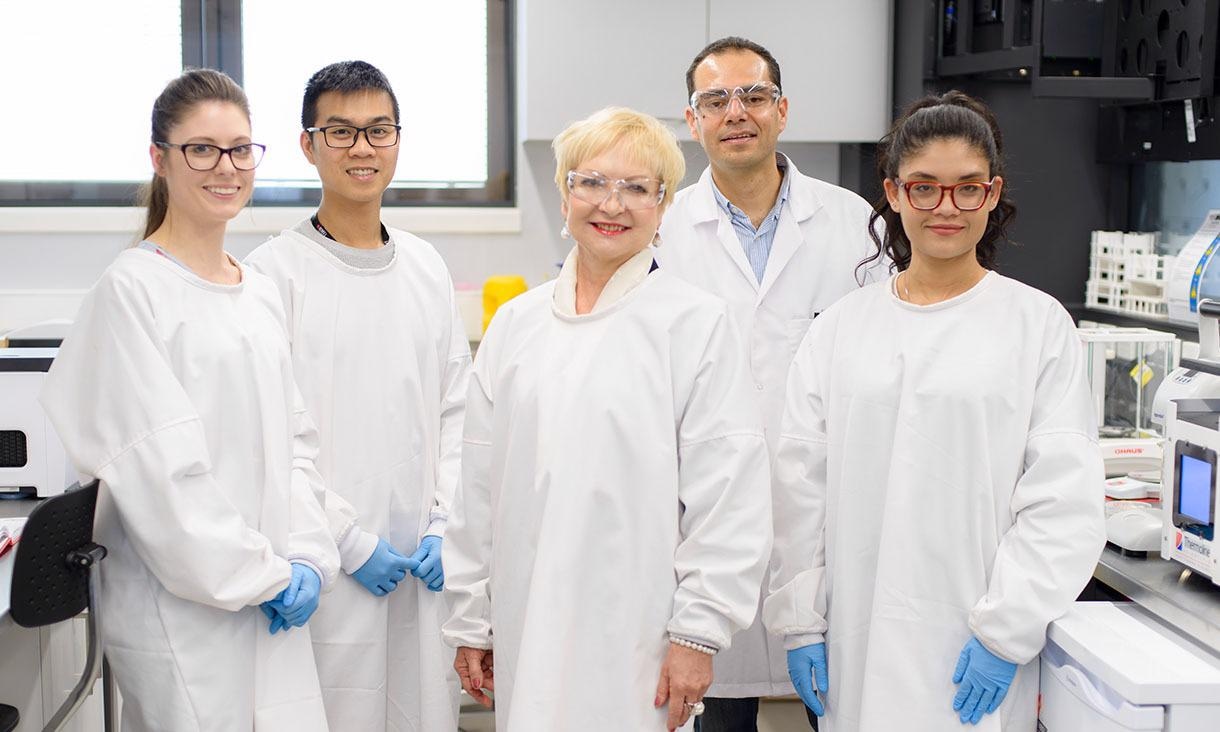Researchers developed a natural antibacterial texture for use on food packaging to extend shelf life and minimize waste, inspired by the bacteria-killing wings of insects like cicadas.
 Multifunctional Mechano-biocidal Materials Research Group: Denver Linklater, Phuc Le, Elena Ivanova, Arturo Aburto-Medina, Karolline De Sousa. Image Credit: RMIT University.
Multifunctional Mechano-biocidal Materials Research Group: Denver Linklater, Phuc Le, Elena Ivanova, Arturo Aburto-Medina, Karolline De Sousa. Image Credit: RMIT University.
An Australian–Japanese team of scientists developed a laboratory-made nanotexture that destroys up to 70% of bacteria and maintains its efficiency when transferred to plastic.
Over 30% of food produced for human consumption is wasted, with whole shipments being discarded if bacterial growth is identified.
The findings pave the way for major waste reduction, notably in meat and dairy exports, as well as increased shelf life and improved safety, quality and integrity of packaged food on an industrial scale.
RMIT University in Melbourne, Australia’s Distinguished Professor Elena Ivanova stated that the scientists successfully introduced a natural phenomenon to a synthetic material — plastic.
Eliminating bacterial contamination is a huge step in extending the shelf life of food. We knew the wings of cicadas and dragonflies were highly-efficient bacteria killers and could help inspire a solution, but replicating nature is always a challenge. We have now created a nanotexturing that mimics the bacteria-destroying effect of insect wings and retains its antibacterial power when printed on plastic.
Elena Ivanova, Distinguished Professor, RMIT University
“This is a big step towards a natural, non-chemical, antibacterial packaging solution for the food and manufacturing industry.”
RMIT, Tokyo Metropolitan University, and Mitsubishi Chemical’s The KAITEKI Institute collaborated on the research. The study was published in the journal ACS Applied Nano Materials.
Australia, in 2015, exported $US3.1 billion worth of food and agricultural goods to Japan, making it the fifth-largest exporter.
How it Works
A wide array of nanopillars — blunted spikes equivalent in size to bacterium cells — adorn the wings of dragonflies and cicada.
The pattern of nanopillars rips bacteria apart when they settle on a wing, rupturing their membranes and destroying them.
It’s like stretching a latex glove. As it slowly stretches, the weakest point in the latex will become thinner and eventually tear.
Elena Ivanova, Distinguished Professor, RMIT University
Ivanova’s group created the nanotexture by duplicating insect nanopillars and creating their own nanopatterns.
Bacterial cells were observed at RMIT’s world-class Microscopy and Microanalysis Facility to analyze the pattern’s antibacterial potential.
The most effective antibacterial designs were exchanged with the Japan team, who devised a method of reproducing the patterns on plastic polymer.
Ivanova’s team evaluated the plastic nanopatterns back in Australia and discovered the one that best reproduced insect wings while also being the easiest to create and scale up.
Plastic, according to Ivanova, is more challenging to work with than other materials, such as silicon and metals, owing to its flexibility.
The nanotexturing created in this study holds its own when used in rigid plastic. Our next challenge is adapting it for use on softer plastics.
Elena Ivanova, Distinguished Professor, RMIT University
Plastic, according to Ivanova, is more challenging to work with than other materials such as silicon and metals because of its flexibility.
Since discovering the bacteria-killing properties of insect wings a decade ago, Ivanova and her colleagues have been striving to build the best nanopattern to utilize insects’ bacteria-killing abilities and apply them to a variety of materials.
Until recently, it was impossible to discover technology that could replicate this nanotexturing on a large enough scale to be used in production.
However, the technology currently exists to scale up and apply antibacterial qualities to packaging, as well as a variety of other uses such as personal protective equipment.
Their new work expands on a 2020 study that looked into utilizing insect-inspired nanomaterials to combat superbugs.
The researchers are eager to collaborate with prospective partners in the next step of the research — upscaling the technology and establishing the best techniques to mass manufacture the antibacterial packaging.
Distinguished Professor Elena Ivanova directs the Mechano-bactericidal Materials Research Group in RMIT’s School of Science. Professor Ivanova is a pioneer in biomimetic antibacterial surfaces.
The Foundation for Australia–Japan Studies funded the study as part of the Rio Tinto Australia–Japan Collaboration Project.
Journal Reference:
Linklater, D. P., et al. (2022) Nanopillar Polymer Films as Antibacterial Packaging Materials. ACS Applied Nano Materials. doi.org/10.1021/acsanm.1c04251.